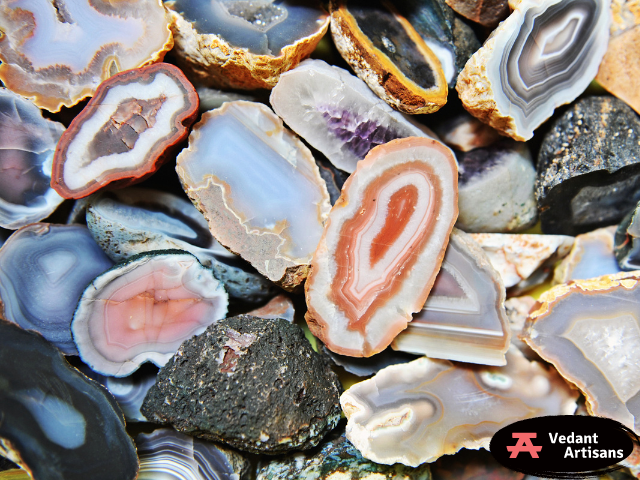Agate, a stunning semi-precious gemstone, is defined by its bright bands of color produced over millennia of geological activity. Its intricate, layered patterns and seductive hues make it a popular material in interior design, where it is used to create unique items which ooze elegance and natural beauty. Agate has historically been used by ancient societies for both artistic and religious purposes. Over time, its applications expanded, and it found its place in furniture manufacturing. Agate table top evolved as a sumptuous statement of style, combining timeless elegance with contemporary craftsmanship, and is still highly sought after within modern interior design.
Design and Crafting Process
Designing and building an agate table top begins with an idea highlighting the stone’s natural beauty. Each phase, from basic design to final assembly, demands meticulous attention to detail to ensure that the end product is physically beautiful and solid in structure.
- Design Development: The creative process of making agate tables starts with design development. Designers draw inspiration from nature and current trends to showcase agate’s distinctive bands and colors. Custom components highlight the stone’s characteristics, creating unique, eye-catching tables. On the other hand, mass-market designs prioritize uniform shapes and patterns, making them more acceptable to a broader audience while keeping the gemstone’s natural beauty.
- Cutting and Shaping: Cutting and shaping agate demands precision and care. Artisans carve into the burdensome stone with diamond-tipped saws, retaining the complex designs. Following cutting, grinders and other instruments shape the slabs into final shapes, meticulously matching round, rectangular, or asymmetrical designs that balance aesthetics and durability.
- Polishing and Finishing: Polishing and finishing are the final stages of the making method. Artisans and the agate with increasingly refined abrasives to obtain a high-gloss finish, highlighting the stone’s vibrant colors and patterns. A resin or epoxy coating is then added, increasing the agate’s longevity and sealing it against moisture while providing a transparent, protective layer showcasing its natural beauty.
Assembly and Table Base Integration
The assembly and table base integration procedure is critical to ensuring that an agate table is beautiful and valuable. This phase is meticulously arranging agate pieces into designs that highlight the stone’s inherent beauty, then fixing the table foundation to provide stability and compliment the aesthetic.
- Arranging Agate Pieces: The agate pieces are carefully arranged to create a visually appealing pattern. Some designs favor symmetrical combinations for a balanced, tidy appearance, whereas others rely on the stone’s natural flaws to produce more abstract patterns. Once the arrangement is complete, artists carefully glue or combine the parts to ensure a seamless, cohesive look.
- Attaching the Base: After placing the agate table top, artisans add a base that matches the desired aesthetic. Metal and wood are popular materials that provide sleek, innovative, warm, traditional looks. The base must be secured appropriately to support the agate’s weight while assuring stability and complimenting the overall table design. This stage requires accurate measurements and changes to ensure that the table is solid and attractive.
Quality Assurance and Final Touches:
Quality assurance and final touches ensure that agate tables match the highest requirements. The method entails a thorough inspection to uncover flaws and rigorous testing for durability. Proper packaging and presentation ensure the table arrives securely and in good condition.
- Inspection and Testing: Quality assurance starts with a comprehensive inspection for cracks, color consistency, and finish quality. Artisans meticulously scrutinize the table’s surface for flaws or inconsistencies that may damage the table’s look or integrity. After the visual checks are completed, the table is tested for strength and durability to guarantee it can sustain regular use. This includes verifying the base’s solidity, examining the bonding of the agate pieces, and ensuring that the protective coating is suitable.
- Packaging and Delivery: Following inspection, the table is ready for delivery. Proper packaging procedures are required to protect the delicate agate surface during transportation, such as unique foam inserts, padding, and secure strapping. To ensure that the table is flawless, it is polished once more shortly before shipping. Once safely wrapped, it is dispatched to the purchaser in pristine condition, ready to display its breathtaking beauty in its new home.
Conclusion
Finally, the exact creation of agate tables exemplifies beauty and craftsmanship. Artists transform raw stones into gorgeous agate table top surfaces by cutting, arranging, and polishing agate slabs to reveal intricate patterns and rich colors. This labor-intensive procedure highlights agate’s innate beauty and distinctive qualities. The finished result is a useful and beautifully appealing masterpiece combining nature’s beauty and human creativity, making agate tables a timeless symbol of elegance.
FAQ’s
Q1. Is agate suitable for a tabletop?
Agate, a quartz known for its banded hues, is a popular tabletop material. Agate is a durable, scratch- and stain-resistant substance. It is also heat resistant, which makes it suitable for kitchen tables.
Q2. Why are agates so unique?
The medicinal effects are said to help treat numerous disorders by restoring balance to one’s physical, emotional, and mental well-being. It is also claimed that each Agate color variation has its distinct characteristics.
Q3. What is an Agate Coffee Table?
An agate coffee table often has a top of agate slices, a semiprecious gemstone recognized for its distinct and colorful banding patterns. The table may have a whole agate slab or numerous agate slices stacked together, commonly polished for a glossy appearance. The agate coffee table basis can be wood, metal, or acrylic to complement the colorful and creative agate table top.


